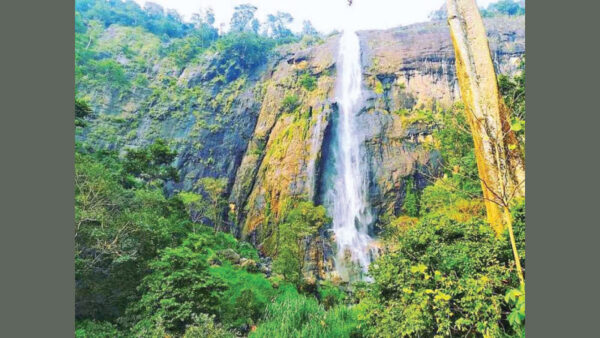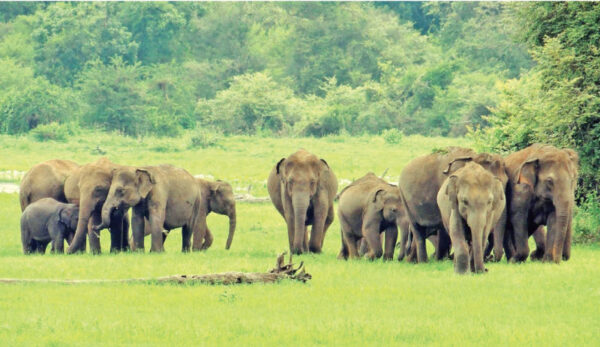An adventure from Poonagala to Diyaluma-by Dishan Joseph

Source:Dailynews
The car made steady progress to Kuruvita from Colombo. After a while I spotted a board advertising a lesser known waterfall, Bopath Ella. One has to travel about 2 Km on a somewhat uneven road to reach these minor falls. The small, yet serene falls is worth the visit as it sets the tone for a deeper adventure. We gradually passed the towns of Pellmadulla, Balangoda and Haldumulla. We stopped for a cup of tea. There were bottles of honey on sale at this small shop. We proceed towards Nikapotha, a solitary town nestled amid dense thickets of trees. Some monkeys were seated on the road, and moved away, with one making defiant gestures. The bright red Post Office building stood out like a vintage sentinel. We moved onto the next town called Koslanda.
After a while, we passed a herd of buffaloes, partly immersed in a pool of mud. Wellawaya had developed much since my last visit this way was about a decade ago. About 4 Km from the main town we traversed the village road. A tractor loaded with king coconuts passed us. Village lasses walked about in floral cotton dresses, their long hair blown by the breeze. Shortly we reached the Kaduruketha Villas of the Jetwing Group. The ancient Walauwa has been beautifully restored, with 25 spacious, cozy chalets. My chalet had an awesome view of the robust Poonagala mountain range.
Bird watcher’s paradise
I came out to the deck, and a peacock looked at me inquisitively. Wellawaya, as I would soon discover, is a bird watcher’s paradise. I enjoy a succulent lunch, which finely showcases village style rice and curry, with Naminda. It was very refreshing to note that paddy is cultivated and harvested by some families in the village, who sell the paddy back to the hotel. This is a fine example of agro-tourism.
After lunch, I caught up with naturalist Hasantha Lokugamage, an expert on wildlife. We began a trek through the village, armed with our binoculars. We soon encountered some peacocks dazzling their majestic feathers. What a magnificent display. I also spotted grey hornbills, the hooded oriole with its yellow and black hue, paradise fly catcher bird with its distinct brown and white feathers, ash doves and a kingfisher. The villagers were friendly and spoke to us. As we walked through a field we witnessed some white Ibis (a rare bird).
The village of Sudupanawela has many green paddy fields. For decades the villagers living here have grown the Gajamadara tree, whose small poisonous fruit keeps elephants away, according to an old man. Hasantha guided me towards a sand path to the lake known as Dhivugahawatte wewa. According to oral tradition the adjacent lands were once an ancient battlefield. I was surprised to see a crocodile, concealed in the lake like a log. I was told that elephants also come to this lake to quench their thirst.
Simple unassuming life
A smiling villager approached me with a plastic jug. I found that the cup was filled with toddy. I took a few sips, to please him and began a conversation. The village folk lead a simple unassuming life. We trekked back to Kaduruketha, and were startled to encounter a large Iguana (thalagoya) crossing our path. Early next morning we were planning to climb to the top of the Diyalauma waterfalls!
Hasantha and I were ready by 5.45 am. It is advisable to do this trek which takes about one hour, before having your breakfast. We drove towards the Beregala road. Smiling children waved as the car passed by. We witness the mountains covered with eucalyptus and pine trees, planted here in the 1950s, introduced as a commercial timber tree. The rigid straight trees were used as posts to sustain the network of electricity wires. The path to this adventure begins inside a section of the Poonagala estate.
We climbed cautiously, with Hasantha leading the way. Soon we spotted some fresh elephant dung. I was hoping not to meet an elephant at such close quarters! After about 35 minutes of brisk walking we came to the section called Uda Diyaluma. The view is quite captivating, and the air was cooler. After a 10 minute break we began to walk across the mountain. This area is covered with citronella plants, whose extract are a natural mosquito repellant.

In another 30 minutes we had achieved our mission – we stood at the topmost sprout of the cascading Diyaluma falls, at 720 feet. The water originates from Poonagala Oya, a tributary of the Kuda Oya. The brilliant view was rewarding. We spotted two large serpent eagles soaring majestically above us. Beyond this mountain range lies the Udawalave National Park. After a short rest and breakfast, we begin the descent. On this wild trek you must check your legs for leeches. It is best to wear boots if you are used to walking in them. Some wild bulls cross ahead of us.
After lunch and an hour’s rest we set out again, in search of some ancient Buddhist heritage sites. The first such site is the Dhematamal Vihara, where according to oral tradition Prince Saddhatissa was kept in hiding by a kind monk. The Prince had argued with his brother Prince Dutugemunu. The monk had subsequently made peace between both brothers and Prince Saddhatissa was put in charge of the kingdom’s agriculture.
I visited Maligawila, a sprawling forest monastery complex with its origins in the 7th Century, where hundreds of monks once lived. The massive 14 metre-Buddha statue has been carefully restored. A few metres away, I was told were the ruins of Kanagama – probably the first hospital for the blind in Sri Lanka. Today, only a few stone columns stand intact. We walked down a sand path and entered the Pathma Vihara monastic complex, built and sustained by Prince Agga Bodhi. Here, elevated on a rock formation stood the 12-metre statue of the Bodhisattva, built according to Mahayana tradition by King Dappula 1. The sunlight was gracefully fading. On the return journey we passed Yuthanagamuwa.
Buddhist history
Sri Lanka is embellished with lots of Buddhist history. From Kaduruketha you can take another 4 Km drive and visit Buduruwagala. It is believed to be one of the first attempts of rock carving in ancient Sri Lanka. I was able to see the massive 52-foot Buddha statue in the centre flanked by two sets of carvings, one depicting the Bodhisattva, flanked by goddess Tara and also the image of one Vajirapani.
A large forest squirrel, (dandu lena) hurried in front of us as we came to the vehicle. You can immerse yourself in the lifestyle of the placid village, for this is where you find the true essence of Sri Lankan life. From this location you can visit four national parks at Yala, Lunugamwhera, Uda Walave and Gal Oya and witness the diverse wildlife. However I must point out that we must not disturb the animals, just to take photos. That is not sustainable wildlife conservation or tourism. Our leopards and elephants must be protected. We must give the animals their space, after all we are in their territory. In roughly two hours you can also drive towards Arugam Bay to enjoy the waves or proceed to the salubrious mountains of Nuwara Eliya and be enchanted by her vintage thrills. Travelling to serene Wellawaya is a memorable journey to unwind and appreciate nature in its raw glory.








